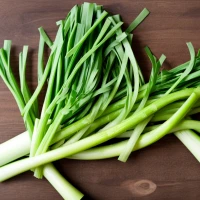Leeks, an underappreciated vegetable quietly nestled in the allium family alongside its more renowned relatives—onions, shallots, and garlic—deserves a moment in the culinary spotlight. A staple in many kitchens, leeks are revered for their versatile flavor profile, boasting a gentle balance between sweetness and earthiness. Leek enthusiasts and gastronomes alike often ponder, what do leeks taste like? In this comprehensive guide, we will peel back the layers of this enigmatic vegetable, unveiling the nuances that make leeks a standout ingredient in culinary creations around the globe.
Understanding the taste of leeks is akin to embarking on a horticultural journey, revealing a symphony of flavors that cater to a wide array of palates. Whether you’re a seasoned chef or a curious home cook, knowing how to describe and utilize the delicate taste of leeks can elevate your dishes from ordinary to extraordinary. Embark with us as we explore every facet of the leek’s flavor spectrum, examining how this vegetable can transform your cooking and awaken your taste buds with its subtle yet distinctive taste.
The Flavor Profile of Leeks: Mild Yet Complex
A Gentle Introduction to Leek Flavors
Leeks are somewhat of a chameleon in the culinary world, easily adapting to and enhancing a variety of recipes. Their taste is often described as a tempered version of their pungent relatives, with a milder and more nuanced character. When considering what do leeks taste like, envision a harmonious blend of gentle onion and a hint of garlic—a palate-pleasing combination that doesn’t overwhelm.
- Subtlety of Fresh Leeks: Freshly harvested leeks are crisp and have a bright, verdant flavor.
- Sweetness When Cooked: Cooking leeks coaxes out their natural sweetness, making them a favored base for soups and stews.
- Nutty Undertones: Upon sautéing, leeks develop a rich, buttery quality with a subtle nuttiness.
The Texture Speaks Volumes
The taste of leeks is irrevocably tied to their texture. When raw, they offer a satisfying crunch that dissipates when cooked, transitioning into a silky, melt-in-your-mouth experience. This textural transformation is a key factor that influences the leek’s flavor profile.
Raw Leeks Versus Cooked Leeks
- Raw Leeks: Crisp and fibrous, with a zesty bite that complements salads and slaws.
- Cooked Leeks: Tender and creamy, becoming a perfect thickening agent for hearty dishes.
Culinary Applications: The Versatility of Leeks in Cooking
Leeks as a Flavor Foundation
Leeks are a cornerstone of classic cuisine, serving as an essential component of the French mirepoix and the Welsh national emblem and dish, leek soup. Their ability to both stand alone as a dish or meld into complex flavor bases underscores their culinary potential.
Incorporating Leeks into Your Recipes
- Soups and Stocks: Leeks infuse broths with depth and a touch of sweetness.
- Braises and Stews: As a robust addition to slow-cooked dishes, leeks contribute a nuanced essence.
- Stir-Fries and Sautees: With a quick cook, leeks remain tender-crisp, imbuing the dish with a subtle garlic-onion flavor.
Vital Tips for Cooking with Leeks
To maximize the flavor of leeks, proper preparation and cooking techniques are paramount. Cleaning leeks thoroughly removes hidden dirt, and slicing them correctly encourages even cooking and optimal flavor release.
Prepping and Cooking Leaks for Best Flavor
- Cleaning Thoroughly: Cut leeks lengthwise and rinse between layers to remove all grit.
- Slicing Techniques: Chop leeks into thin slices for even cooking and maximum flavor exposure.
- Cooking Methodologies: Sauté leeks on low heat to caramelize their natural sugars, or braise them to accentuate their mellow sweetness.
Nutritional Benefits of Leeks: A Healthful Delight
Leeks are not only a flavor enhancer but also a treasure trove of health benefits. Packed with vitamins, minerals, and antioxidants, leeks offer a range of nutritional advantages.
Vitamin and Mineral Rich
Leeks are an excellent source of vitamin A, vitamin K, and vitamin C, as well as minerals like iron and manganese. This rich nutrient profile can play a vital role in maintaining overall health.
- Vitamin A: Important for vision and immune function.
- Vitamin K: Essential for blood clotting and bone health.
- Iron and Manganese: Crucial for energy production and antioxidative processes.
Dietary Fiber: A Digestive Aid
With a high fiber content, leeks promote digestive health by aiding regularity and potentially reducing the risk of chronic diseases related to the digestive system.
Pairing Leeks with Other Flavors: A Match Made in Heaven
Leeks have an innate ability to complement and enhance other ingredients, making them an ideal pairing partner in the kitchen.
Harmonizing with Herbs and Spices
What do leeks taste like when paired with the right seasonings? They can either take center stage or provide a delicate backdrop, depending on the combination of herbs and spices used.
Ideal Seasonings for Leeks
- Thyme and Tarragon: Herbs that underscore the earthy tones of leeks.
- Black Pepper and Salt: Enhancing the natural flavors without overshadowing them.
Leeks in Symbiosis with Proteins
Whether it’s the delicate flesh of fish or the robustness of red meats, leeks can elevate the overall dining experience.
Protein Pairings for Optimal Taste
- Fish and Seafood: The gentle taste of leeks doesn’t overpower the subtleties of seafood.
- Poultry and Pork: Leeks add a depth of flavor that complements these proteins beautifully.
The Cultural Significance of Leeks: From Ancient Times to Modern Tables
Leeks have held a place of esteem in various cultures throughout history, and understanding their role can enrich our appreciation for this humble yet mighty vegetable.
A Historical Perspective on Leeks
From ancient Egyptian diets to the leek-adorned caps of Welsh soldiers, leeks have a rich cultural tapestry. They are celebrated for their taste and nutritional value, as well as their symbolic significance in various traditions.
Contemporary Celebrations of Leeks
Today, leeks continue to be a valued ingredient across numerous cuisines, featured prominently in dishes like Scottish cock-a-leekie soup and several Eastern European favorites.
Growing and Harvesting Leeks: Farm to Table
For those interested in where their food comes from, exploring how leeks are cultivated can provide a deeper connection to the dishes they create.
Cultivating Leeks at Home
Gardening enthusiasts may be intrigued by the prospect of growing leeks in their private plots. This can ensure the freshest, most flavorful leeks for their culinary endeavors.
Steps to a Successful Leek Harvest
- Soil Preparation: Leeks require well-drained, fertile soil.
- Planting: Start leeks from seeds or seedlings, giving them ample space to expand.
- Care: Regular watering and weeding will result in a healthy leek crop.










